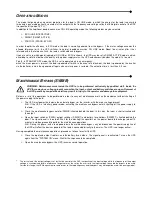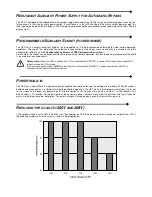
E
XTERNAL
P
ROTECTIVE
D
EVICES
MAGNETOTHERMAL
As explained previously, the UPS has protection devices for output faults as well as for internal faults.
In order to set up the power line, install a magnetothermal switch upstream from the UPS with intervention curve B or C. Please
follow the indications in the table below:
Automatic external protective devices
UPS mod.
Mains input
Separate bypass input (optional)
10 kVA
40A
40A
12 kVA
40A
40A
15 kVA
63A
63A
20 kVA
63A
63A
If the protective device upstream from the UPS interrupts the neutral wire, it must also interrupt all the phase wires at
the same time (four-pole switch).
Output protections (recommended values for discrimination)
Normal fuses (GI)
In (Nominal current)/7
In (Nominal current)/7
Normal switches (C curve)
In (Nominal current)/7
In (Nominal current)/7
Ultra-fast fuses (GF)
In (Nominal current)/2
In (Nominal current)/2
DIFFERENTIAL
In versions with no input separation transformer, the neutral from the mains power supply is connected to the UPS output
neutral; as a result, there will be no change to the neutral arrangements of the installation:
THE UPS INPUT NEUTRAL IS CONNECTED TO THE UPS OUTPUT NEUTRAL
THE DISTRIBUTION SYSTEM THAT POWERS THE UPS IS NOT MODIFIED BY THE UPS
The neutral condition is only modified if an isolation transformer is present or when the UPS works with a neutral
isolated upstream.
Make sure that the equipment is connected correctly to the input neutral because as damage may be caused
to the UPS.
During operation with the mains supply present, a differential switch (RCD) at the input to the UPS will activate should a fault
occur on the output side as the output circuit is not isolated from the input circuit.
In any case, other differential switches may still be installed on the output, preferably in coordination with those present at the
input.
The differential switch located upstream must have the following characteristics:
Differential current adjusted to the sum of UPS + Load; we recommend a suitable margin be kept to prevent unwanted
activation (100mA min. - 300mA recommended)
Type B or type A
Delay of at least 0.1s
















































